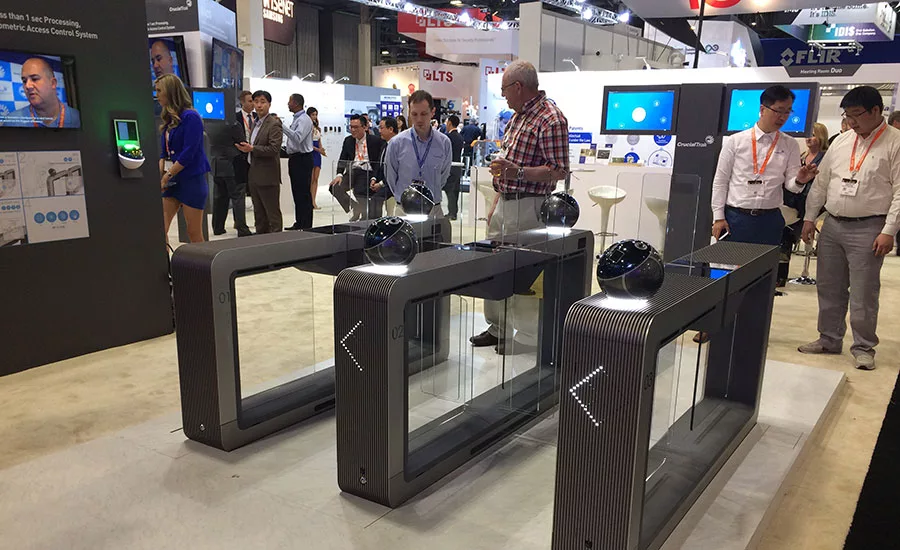Business Intelligence, Cybersecurity and Biometrics Took Center Stage at ISC West 2017

Like many of you, we spent most of last week at ISC West in Las Vegas surrounded by the crush of massive crowds eager to get a glimpse of the next great security product, to discuss new solutions with vendors and integrators, and to network with one of the most varied and comprehensive groups of security professionals in one (enormous) place.
Security’s editorial staff spent the show dashing from booth to booth, discussing trends, technology and tips with security manufacturers, consultants, integrators and end users alike (if we ran into you in the aisles, we apologize). Through these meetings, a broader picture of the industry materializes: Manufacturers are working to meet end users’ request for actionable business intelligence, to offer enterprises a chance to accomplish more with the data security systems already generate. The demand for stronger cybersecurity was felt across the show floor, as some manufacturers were overtly advertising cyber-secure cameras or appliances. And while it may be slow to catch on in installations, biometric technology is advancing by leaps and bounds.
Business Intelligence
Enterprises invest heavily in surveillance cameras and sensors, but they’re still considered a cost center, especially as higher megapixel counts lead to dramatically higher storage costs. This year, we saw an added push from many vendors to make better use of the data generated by existing or new security systems.
This has included expanded analytics offerings to provide heat-mapping, people-counting, traffic patterns and more. We have seen many of these before, but they are being honed to a finer, more actionable science, with easy-to-share reports and automatically compiled data sets.
Other vendors were showcasing more streamlined integration, so enterprises could apply analytics to, say, sensors above cash registers that trigger an automatic audio alert over IP speakers when queues are too long to call for more cashiers.
According to Sean Murphy from Bosch, the average security application uses only 10% of the data it produces. Analytics help enterprises tap into the other 90% of the data created and built actionable business intelligence out of it for customer service, facility use and maintenance and more.
Cybersecurity
After a number of high-profile cyberattacks facilitated by weak surveillance camera security, we saw this conversation take a new turn at the ASIS Annual Seminars & Exhibits last September, but the cybersecurity of security systems was front and center at ISC West. Nearly every camera manufacturer was prepared to explain or demonstrate their commitment to cybersecurity, and a few were touting their investments in cybersecurity technology and education, such as the Camera Hardening Guides for end users and integrators at Axis Communications.
ComNet unveiled its Port Guardian product, which senses when an IP camera cable has been disconnected and automatically locks down that port and sends an alert to an administrator, so a malicious actor cannot plug in a laptop or other device to the camera’s cable and gain access to the network.
Razberi introduced its Camera Defense appliance, which rolls five cybersecurity best practices and services (MAC address binding, firewalls, whitelisting, Internet protection and password protections) into one device, offering cybersecurity protection for anything plugged into its switch, from access control readers to cameras.
Biometrics
Historically, biometric solutions have been reserved for high-security facilities where an added layer (or three) of identity verification is required, such as pharmaceutical facilities or data centers. However, as manufacturers make strides in the speed and ease of user enrollment, durability of machinery and reductions in false rejections, the industry may be primed to see biometrics move mainstream.
The winner of the SIA New Product Showcase was the Biometric Access Control System (BACS) from CrucialTrak. This gate solution uses five cameras contained in one orb-like device to capture images of a user’s fingerprints, palm print, iris and face. Depending on the organization using it, the system can be configured to accept the first positive identification it encounters (likely facial recognition as one walks up to the gate) or all four (with the hand hovering over the orb). Managing Director Daniel Gold says it could prove to be a useful and popular solution for universities, hospitals or other facilities where hygiene is a factor, as (operated properly) the system is touchless for users.
FST Biometrics was demonstrating the speed at which users can be enrolled in its biometric-based identity management system, as well as new upgrades to detect and prevent fraud (the system can tell the difference between a photo of a user’s face and their actual face, and it cross-checks recent and historical images to combat failure rates due to aging faces).
What We’re Looking for Next
Based on what we’ve seen presented at the past few tradeshows, we’re expecting to see more emphasis on smart or connected buildings that use existing and new security sensors to streamline utilities, resource use and spending. The technology is at a good jumping off point, but now we have to wait for these solutions to be more widespread and in use for additional applications to emerge.
We’re also waiting for more integrators and dealers to jump on the cybersecurity train. Manufacturers are working to provide solutions, guidance and education, but without buy-in from the people configuring and installing systems, breaches will still occur. End users need to join in here as well. Configuring a system correctly for cybersecurity takes time; it’s not a plug-and-play situation. So accepting a higher bid for a longer, higher security installation may be in a CSO’s best interest.